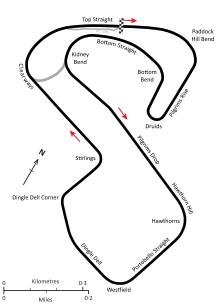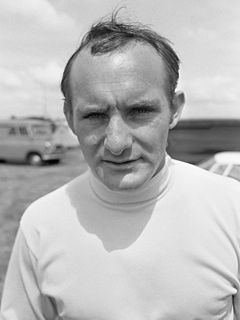
Stanley Michael Bailey Hailwood, was a British professional motorcycle racer and racing driver. He is regarded by many as one of the greatest racers of all time. He competed in the Grand Prix motorcycle world championships from 1958 to 1967 and in Formula One between 1963 and 1974. Hailwood was known as "Mike The Bike" because of his natural riding ability on motorcycles with a range of engine capacities.

Pat Hennen is an American former Grand Prix motorcycle road racer. He is notable for being the first American to win a 500 cc World Championship race, the 1976 500cc Finnish Grand Prix. Competing as a non-factory rider, he finished third overall in the GP World Championship standings that season, only 2 points behind runner-up Tepi Länsivuori and fellow Suzuki factory rider Barry Sheene.

Phillip William Read, was an English professional motorcycle racer. He competed in Grand Prix motorcycle racing from 1961 to 1976. Read is notable for being the first competitor to win world championships in the 125 cc, 250 cc and 500 cc classes. Although he was often overshadowed by his contemporary, Mike Hailwood, he won seven FIM Grand Prix road racing world championships.

The Triumph Trident and BSA Rocket 3 was a technically advanced, high-performance roadster motorcycle made by Triumph Engineering and BSA from 1968 to 1975, and sold under both the Triumph and BSA marques. Alongside the Honda CB750, and later the Kawasaki triples, it brought a new level of sophistication to street motorcycles, marking the beginning of the superbike era. The Honda CB750 overshadowed the Trident to be remembered as the 'first superbike', in spite of the Triumph Trident actually debuting before the Honda by a few weeks.
Yvon Duhamel was a French Canadian professional motorcycle and snowmobile racer. A six-time winner of the White Trophy, the highest award in Canadian motorcycle racing, he was one of the most accomplished motorcycle racers in Canadian motorsports history. Duhamel was a versatile rider competing in numerous motorcycle racing disciplines including; trials, motocross, ice racing, drag racing, flat track racing and most prominently in road racing as a member of the Kawasaki factory racing team. His motorcycle racing career spanned the transition from the 60 horsepower four-stroke motorcycles of the 1960s, to the 100 horsepower two-stroke motorcycles of the 1970s. Even when Duhamel's motorcycle had a top speed advantage, he never slowed to conserve his machine, which led to spectacular crashes or mechanical failures as often as it led to race victories. Duhamel's reputation as a tenacious competitor with an aggressive riding style earned him the respect of other racers and made him popular with racing fans.
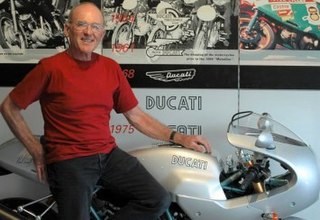
Paul Smart was an English short circuit motorcycle road racer who later entered Grands Prix.

Douglas Lionel Hele was a pioneering British motorcycle engineer with Triumph and other firms: BSA, Douglas and Norton. He was born in Birmingham in 1919 and died in Hagley, Worcestershire on 2 November 2001.
Dick Mann was an American professional motorcycle racer. He was a two-time winner of the A.M.A. Grand National Championship. Mann was inducted in the Motorsports Hall of Fame of America in 1993, and the Motorcycle Hall of Fame in 1998. He was one of the few riders to ride motocross and Observed Trials as well as dirt flat tracks, TT and road racing.
Gene Romero was an American professional motorcycle racer. He competed in the A.M.A. Grand National Championship from 1966 to 1981 sponsored first by the Triumph factory racing team and then by the Yamaha factory racing team. Proficient on oval dirt tracks as well as paved road racing circuits, Romero won the 1970 A.M.A. Grand National Championship and was the winner of the 1975 Daytona 200. After retiring from competition, he became a successful racing team manager with Honda and, helped the sport of dirt track racing by becoming a race promoter. Romero was inducted into the AMA Motorcycle Hall of Fame in 1998.
The Thruxton 500 was a motorcycle endurance race for production based road machines, covering 500 miles and ridden by a team of two riders per machine. The first event was a 9-hour race which took place in 1955, organized by the Southampton and District Motorcycle Club (SDMCC) at the Thruxton Circuit near Andover in Hampshire. Two more 9-hour races followed in 1956 and 1957.
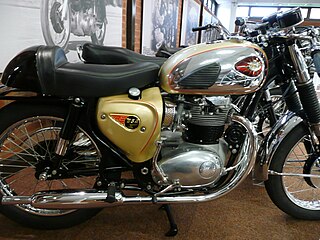
The BSA Lightning Clubman was a 650cc British motorcycle made by BSA at their factory in Birmingham between 1964 and 1965. Finished in gold and black the Lightning Clubman is now a highly sought after classic motorcycle. Due to the very limited production numbers replicas are created by enthusiasts from the BSA Lightning.
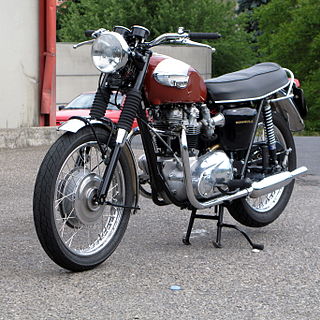
The Triumph Bonneville T120 is a motorcycle originally made by Triumph Engineering from 1959 to 1975. It was the first model of the Bonneville series, which was continued by Triumph Motorcycles Ltd. The T120 was discontinued in favour of the larger 750 cc T140 in the early 1970s.
Percy Tait was an English professional motorcycle road racer and senior road tester for Triumph motorcycles, where he was estimated to have covered over a million miles of road testing. He later became a farmer specialising in award-winning rare breeds of sheep.

The Dunstall Norton was a Norton motorcycle made by Paul Dunstall, a specialist tuner of the 1960s and early 1970s twins originally using some parts from Norton's Domiracer project when the Birmingham factory was closed in 1963. In 1966 Dunstall Motorcycles became a motorcycle manufacturer in its own right so that Dunstalls could compete in production races, and set a number of world records before sales of the Dunstall Nortons declined in the 1970s consistent with the demise of the British motor cycle industry and a corresponding rise in Japanese imports.
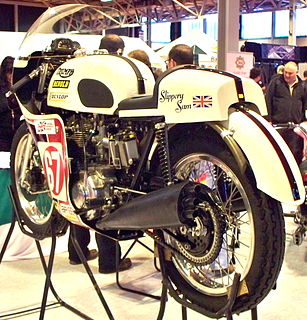
Slippery Sam is a British production class racing motorcycle from the early 1970s that used a carefully prepared version of the 750 cc Triumph Trident ohv (pushrod) three-cylinder engine. The "Slippery Sam" name was acquired during the 1970 Bol d'Or, a 24-hour race for production-based machines held in France, when engine difficulties and escaping oil covered the bike of Triumph employee Percy Tait and co-rider Steve Jolly who managed to finish in fifth place to winners Paul Smart and Tom Dickie on another works Trident.

BSA motorcycles were made by the Birmingham Small Arms Company Limited (BSA), which was a major British industrial combine, a group of businesses manufacturing military and sporting firearms; bicycles; motorcycles; cars; buses and bodies; steel; iron castings; hand, power, and machine tools; coal cleaning and handling plants; sintered metals; and hard chrome process.
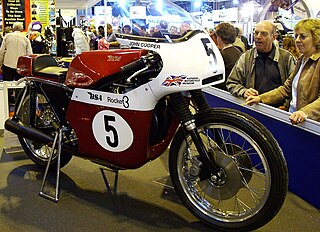
The Transatlantic Trophy was an annual series of motorcycle races between the United Kingdom and America held from 1971 to 1988 and again in 1991. They were mostly held over the Easter weekend at Brands Hatch, Mallory Park and Oulton Park, although some races were held at Donington Park and Snetterton. Three different specifications of motorcycles were used in the series at various times: AMA/F750, Superbike and GP.
Don Castro is an American former professional motorcycle racer who is an inductee of the AMA Motorcycle Hall of Fame. During his career he was a works rider for Triumph and Yamaha' and a privateer on Triumph, Montesa, Yamaha and Kawasaki machines.

The BSA/Triumph racing triples were three cylinder 750 cc racing motorcycles manufactured by BSA/Triumph and raced with factory support from 1969-1974. There were road racing, production racing, endurance racing and flat track variants. The machines were based on the road-going BSA Rocket 3/Triumph Trident.

The John Player Norton, also referred to as JPN and JPS Norton, were a series of Formula 750 racers manufactured by Norton Motorcycle Company from 1972 to 1974 and sponsored by cigarette manufacturer John Player. The engine for these machines was derived from the unit used in the Norton Commando, which was a development of the 1948 Bert Hopwood designed 500 cc Dominator. The lack of power from the engine, compared with other manufacturers, led designer and rider Peter Williams to a adopt a radical approach to chassis design. Riders of the bikes included Williams, Phil Read, Tony Rutter, Mick Grant, John Cooper, Dave Aldana and Dave Croxford.

